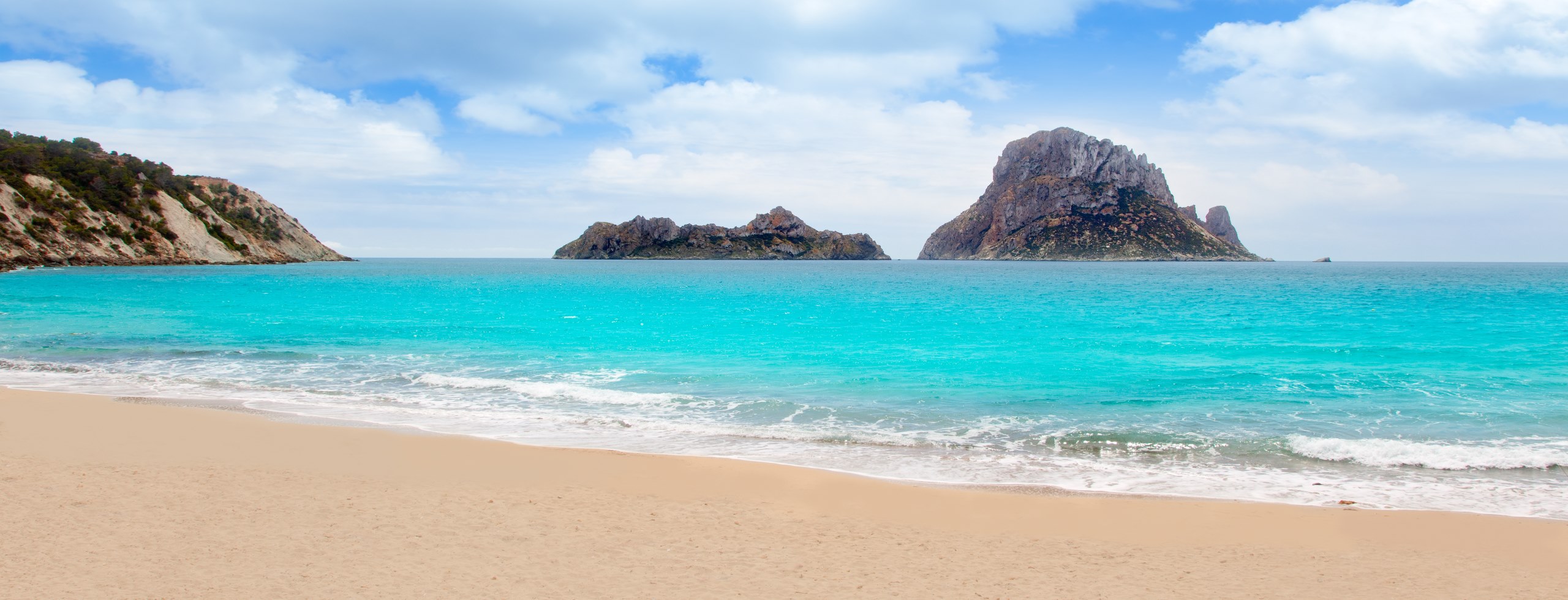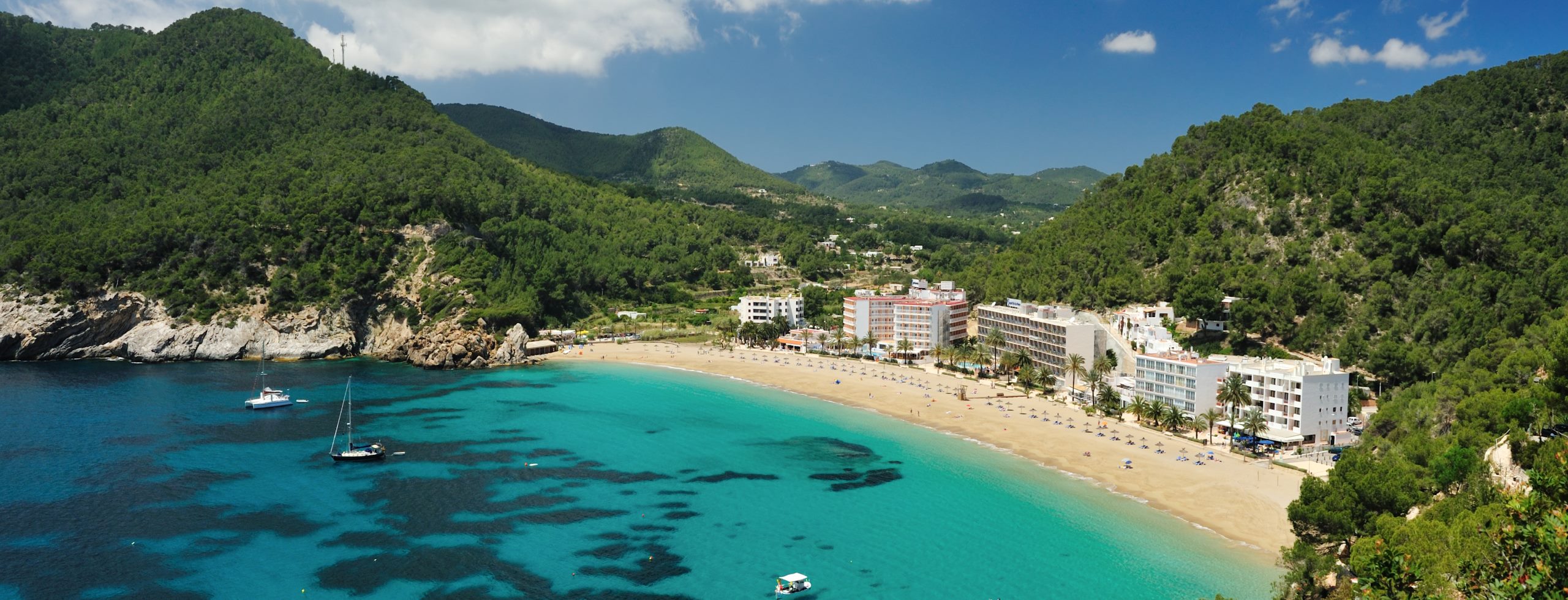Route 1: Exploring the Island of Ibiza
What can one say about Ibiza? To pretend that most people go there – 6 million during high season – for something other than the beaches and club scene would be like claiming that people go to Venice for its landscaping. And yet, there is much more to Ibiza than its famed nightlife. Ibiza town, the capital and transportation center, has an old quarter that has been designated as an UNESCO World Heritage Site. Known as the Dalt Villa, it sits on the city’s high ground enclosed in 16th century ramparts linking seven bastions; the walls are so intact that you can walk the entire perimeter along the top. Cobblestoned lanes ascend to the cathedral, its core dating to the 14th century, but with major additions in the 16th and 18th centuries. Nearby is the Madina Yasiba La Curiá with its displays commemorating the time, from 990-1235, when Muslims ruled Ibiza. The only other urban centers that visitors are apt to seek out are Sant Antoni de Portmany located on the west coast, Santa Eulalia del Rio on the east coast, and in the northcentral region, Sant Miquel de Balansat, Santa Gertrudis de Fruitera, and Balafia.
Almost all of the other built-up areas are now dominated by strings of resort hotels, for Ibiza’s other magnet for visitors: sunny, quiet, and restful natural beaches. The island is ringed with beaches; Playa d’en Bossa, Playa d’es Cavallet and Aigua Blanca tend to be the most nudist-friendly and gay-friendly. If you prefer to stay close to Ibiza town, Playa Talamanca is just next-door, while only a few kilometers down the coast are Ses Figueretes and Las Salinas. Many of these beaches offer all variety of gear for watersports, and there is an authorized scuba diving center in Ibiza town. It should also be noted that its not by chance that Ibiza was long known as “Pine island” – as small as it is (one-sixth the area of Mallorca) – its interior does not only have pines trees, but a variety of greenery that makes driving around most pleasant; there is even a bird sanctuary at the Natura Park of Las Salinas at the southern tip of the island.
Finally, as night descends and those who enjoy clubs and dancing will begin their night exploration, Sant Antoni de Portmani on the west coast, and some beaches such as Playa d’en Bossa are ideal points to start. The music is mainly of the electronic variety – house, trance, and techno – presided over by internationally renowned DJs. If you’re looking for a good party, you won’t be short of options as Ibiza is host to some of the world’s most renowned clubs. The entrance price is not inexpensive but clearly many people feel they get their money’s worth at one of these famous clubs.
Route 2: Exploring the Island of Formentera
If you are looking for a more off-the-beaten-path experience, then just a few kilometers from the mainland is the tiny island of Formentera. Only some 84 sq. kms (32 sq. miles) in area, there are several smaller islets that officially belong to it and Formentera has long served as a retreat from Ibiza’s crowds during high season. The island’s beaches are excellent – known especially for their extraordinarily white sand and blue waters. Some beaches are less crowded than others; on the coast south of the capital city of Sant Frances Xavier is the Playa de Migjorn, while on the north coast of the southeastern most promontory are the beaches of Es Calo. But even at more popular beaches, such as Cala Salona (just south of Sant Frances) and Playa de ses Illetes (to its north), you can chose to bathe at the less crowded sections.
What else does Formentera offer? For one thing it is small and flat enough so that a rented moped or bicycle is one way to check out the island. Over on the east coast, outside the small town of Sant Ferran de ses Roques, is the Cova d’en Xeroni, a cavern with stalagmites and stalactites, but quite unpredictable viewing hours. On the tip of Cape Barbaria is a lighthouse and an 18th century watchtower, while another lighthouse is on the tip of the promontory to the east of Cape Barbaria – the Far de sa Mola. At the northernmost tip of the island you will find yourself looking at a tiny islet of Espalmador and beyond it to Ibiza’s National Park of Ses Salines. Espalmador does have some inviting beaches and some people do try to swim here despite the strong current. Another alternative is to take a small boat trip from the little port of La Savina at the base of the narrow promontory. This just about exhausts sightseeing on Formentera, but you’ll also want to get a taste for the bars and restaurants in the capital San Frances Xavier or in the town of Sant Ferran de ses Roques.
The first settlers on the island were the Phoenicians in 654 BC, the main source of income was the production of dye, salt, fish sauce, and wool. Until today the people of Ibiza have been exporting salt, also known as ‘the white gold.’ Around 600 BC the Phoenicians established a port town and called it ‘Ibosim,’ or ‘Island of Bes’ after the Egyptian god who defended everything good.
After the decline of Phoenicia, Ibiza came under control of Carthage who established a shrine to the goddess Tanit, goddess of fertility, in the cave at Es Cuieram (the cave can still be visited today); the Carthaginians exploited the salt beds of the island, making the island’s economy flourish. By 400 BC, Ibiza was a major trading post along the Mediterranean routes and began establishing its own trading stations along the coast of other nearby Balearic Islands, like Mallorca.
During the Second Punic War (between the Romans and Carthaginians) in 209 BC, Ibiza negotiated a favorable treaty with the Romans, allowing it to be spared from destruction and to continue its Carthaginian-Punic institutions until it officially became a Roman municipality called ‘Ebusus.’ Following the fall of the Roman empire, the island was ruled by the Vandals and then the Byzantines, until early 700 AD when Ibiza was occupied by Arabs and came under Islamic rule. ‘Yehbisa,’ as the island was called, was under Arab rule for almost five centuries; it flourished economically as the Arabs had established it as a trading port with the Spanish mainland.
In the spring of 1110 AD the Balearic Islands were invaded by Norwegian King Sigurd I on his crusade to Jerusalem, and in 1235 Ibiza was conquered by the Spanish King of Aragon James I. The local Muslim population was deported and new Christian colonists were brought in, but the island maintained its own self-government in different forms until 1715 when King Philip V of Spain abolished the local government’s autonomy.
Ibiza had long been known for its free-thinking, and in the 1950s liberal thinkers from the Spanish mainland fled to the island to escape the fascist rule of general Franco. The so-called hippies brought a fantastic era of tribe-like free thinkers including writers, artists and musicians. The 1960s saw the beginning of the tourist boom and Ibiza attracted many travelers from around the world. In the late 1970s, Ibiza along with the other Balearic Islands became an Autonomous Community of Spain.



 View Map
View Map 

